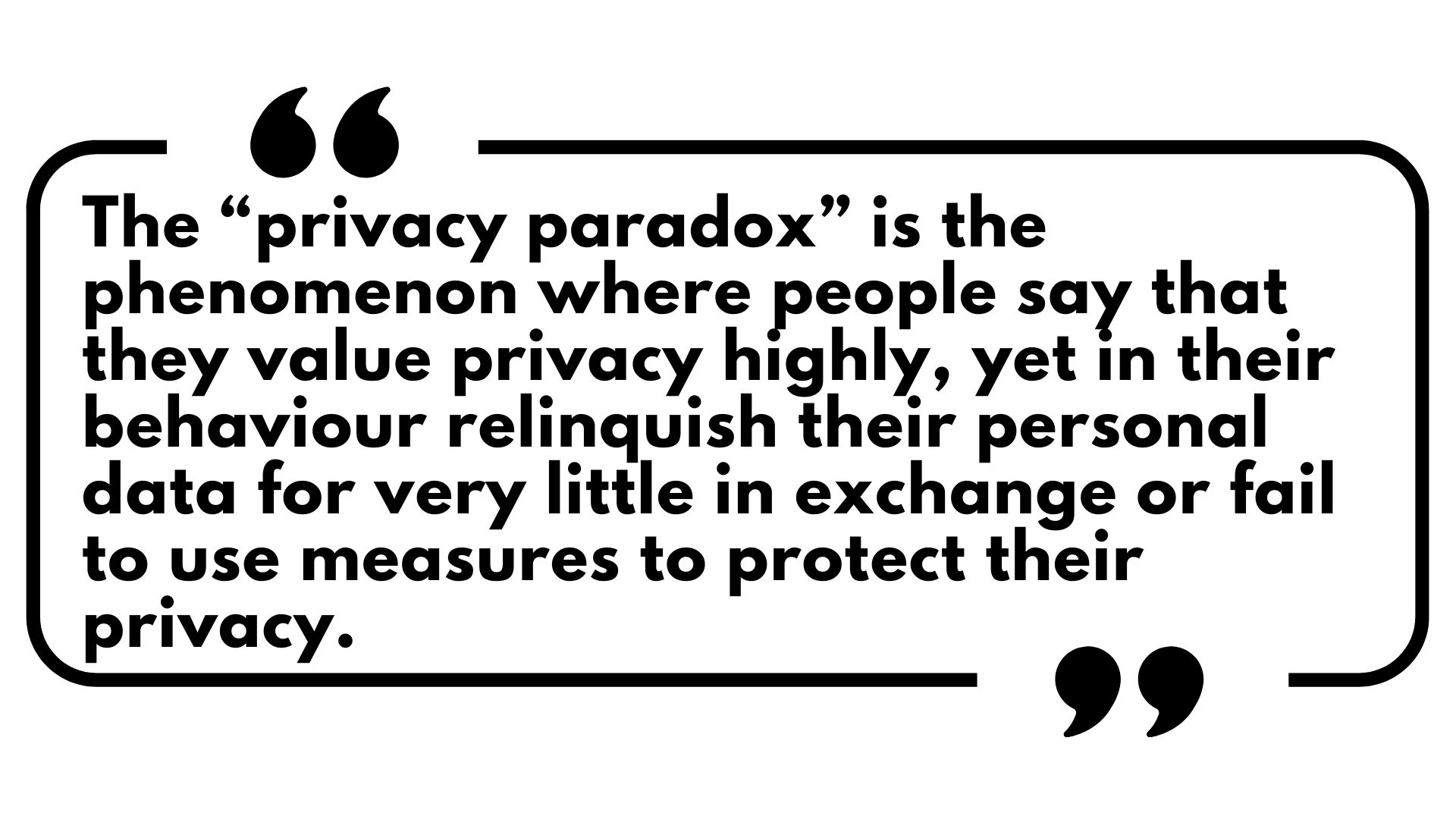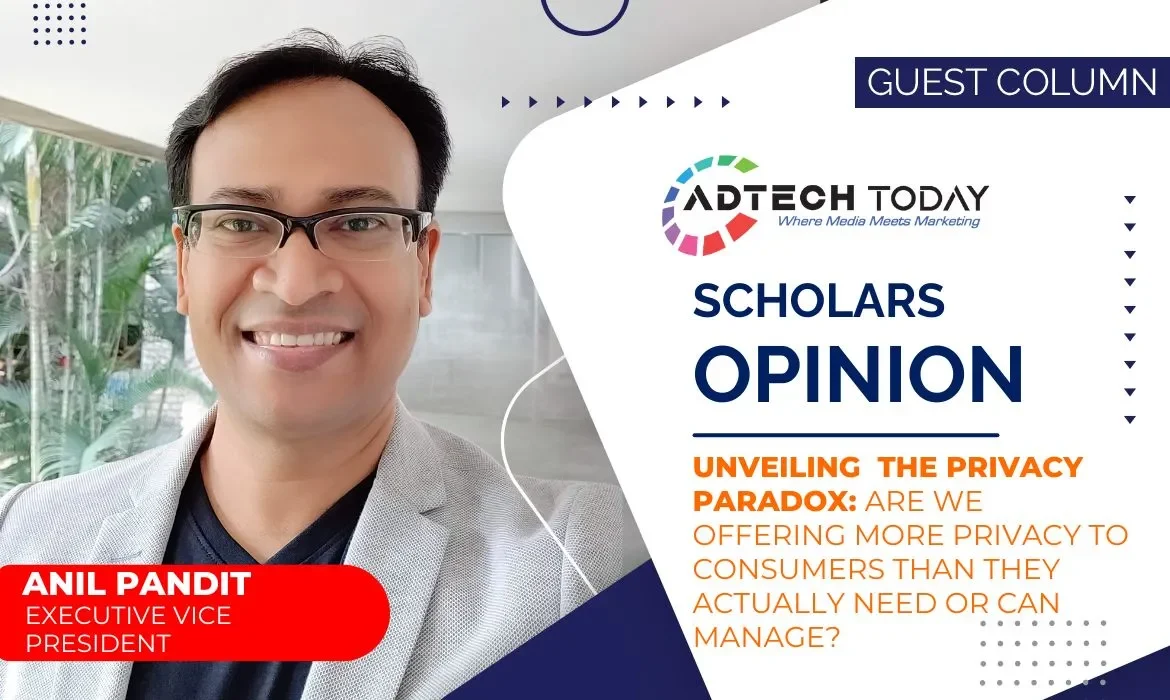Unveiling the Privacy Paradox: Are We Offering More Privacy To Consumers Than They Actually Need or Can Manage?
Welcome to Privacy Paradox!
The Privacy Paradox is a captivating duality. It resides in the tension between consumers’ unwavering concern for privacy and their enthusiastic embrace of personalized experiences. This paradox challenges our understanding of the boundaries between individual sovereignty and data-driven convenience.
Nowadays, the border between private and public is becoming more and more blurred; people are used to sharing their pictures, videos, preferences, and personal information, and every day a huge amount of online data is collected, however, they still appear to be seriously concerned about their privacy and claim it to be an important factor in their online decision-making process.
Alen Westin tried segmenting users into three big categories:
- Privacy fundamentalists: very privacy-oriented and concerned
- Privacy unconcerned: not at all privacy-oriented
- Privacy pragmatists: in-between the other two categories
Westin’s segmentation methods, however, cannot establish that users are pragmatic in theory or in practice. This has led to some groups proposing that the “privacy vulnerable” and “privacy resilient” groups are more usable segmentation categories than the tripartite Westin categories.
While the debate can continue, let’s look at some of the reasons for this Privacy Paradox to exist:
Convenience
Users willingly trade privacy for the ease of ordering products, using social media, or accessing personalized content.
Lack of Awareness
Users may not fully comprehend the extent to which their data is collected and used by online platforms due to complex privacy policies and legal jargon.
Social Pressure
Fear of missing out (FOMO) or social pressure often drives users to engage in sharing behaviours on social media even when they are uncomfortable with it.
Psychological Biases
People tend to believe that privacy breaches won’t happen to them, leading to a perception of invincibility. Humans tend to underestimate the risks and overestimate the benefits of sharing data. This cognitive bias often leads to consumers’ willingness to disclose more than they should.
In general, consumers appear to be much more sensitive about the use of their medical, financial, and family information than they are about their product, brand consumption or their media usage behaviour.
We continue to candidly divulge personal information, click “accept” to cookie notices and terms of service, use identical passwords for multiple websites, and generally underestimate the worth of our data. It can be difficult to place a concrete value on privacy because we often don’t realize its value until we’re tangibly and conspicuously harmed. If we haven’t been affected by the loss of privacy in the past – whether a hack, a phishing scam, or even creepy targeted advertising – the risks seem abstract and hard to quantify, almost as if it’s not our problem.

The reason for people’s failure to manage privacy effectively, I argue, is based on the futility of what I call “privacy self-management.”
Privacy self-management involves the various decisions people must make about their privacy and the tasks people are given the choice to do regarding their privacy, such as reading privacy policies, opting out, changing privacy settings, and so on. The best people can do is manage their privacy haphazardly.
Some of the ways we can leverage the Privacy Paradox for Better Privacy Regulation are:
- Behavioural Insights: Regulators can analyze user behaviours to understand the gap between privacy concerns and actions, guiding the creation of policies that bridge this divide.
- Incentivizing Compliance: Regulations can incentivise businesses that prioritize privacy and penalize those that disregard it, aligning corporate interests with user privacy.
- User-Centric Regulations: Policies can be designed to give users more control over their data and ensure transparency in data handling practices.
- Public Awareness Campaigns: Governments can launch campaigns to educate citizens about online privacy, making them more privacy conscious.
DPDP Act of India has a lot of inbuilt mechanisms to solve this paradox.
Privacy regulation can be best strengthened by regulating in ways that don’t rely on individuals managing their own privacy. Instead, privacy regulation should focus on regulating the architecture that structures the way information is used, maintained, and transferred. I hope the government of India is making right strides towards that with a lot of mandatory provisions in the DPDP Act 2023.
Rather than a true paradox, it’s a reflection of consumers’ evolving preferences and concerns. Advertisers can thrive in this environment by embracing trust, transparency, ethics, and empowering consumers.
We are simultaneously the gatekeepers and the invaders of our own privacy in the digital age.
Case Studies:
#1. In a study, subjects were asked to purchase Bluetooth Speakers from one of two identical stores. One store sold the Speakers for 500 INR less than the other, but the cheaper store requested more sensitive data. Both stores requested the subject’s name, postal address, and email address. However, the cheaper store required date of birth and monthly income whereas the more expensive store required year of birth and favourite colour. Despite 95% of subjects saying that they were “interested in the protection of their personal information” and 75% saying that they “have a very strong interest in data protection,” nearly all subjects chose the store with the cheaper price but requiring more personal data.
#2. A study involving smartphones and the downloading of mobile apps concluded that “despite the fact, that users still claim to be concerned about the potential misuse of their personal data, they remain unwilling to invest either the time and effort or the money necessary to protect their privacy.”
#3. Even after the Cambridge Analytica data scandal broke, only 8% of respondents in a study said they would stop using Facebook.
This article is written by Anil K Pandit, Executive Vice President

Anil Pandit
Digital | Data Privacy | Tech | Programmatic | Martech | Artificial Intelligence for Business | Digital Marketing
Anil has a rich background spanning over two decades in digital and mobile marketing. He brings a wealth of experience in delivering exceptional performance and driving growth across diverse verticals and platforms. He is on a mission to empower marketers with the skills and resources necessary to leverage data and technology, to drive success in an ever-evolving digital landscape.
Author Profile
- admin
Latest Posts
 Interview and Guest PostJuly 25, 2024Unlocking the Power of Generative AI in Marketing
Interview and Guest PostJuly 25, 2024Unlocking the Power of Generative AI in Marketing Interview and Guest PostJuly 18, 2024Sustainability in Advertising – Going Green in the Digital Age
Interview and Guest PostJuly 18, 2024Sustainability in Advertising – Going Green in the Digital Age Interview and Guest PostJuly 10, 2024Beyond the Buzz: Real-World Digital Transformation
Interview and Guest PostJuly 10, 2024Beyond the Buzz: Real-World Digital Transformation Interview and Guest PostJuly 5, 2024Retail Media Networks: What is your Audience’s True Worth?
Interview and Guest PostJuly 5, 2024Retail Media Networks: What is your Audience’s True Worth?








